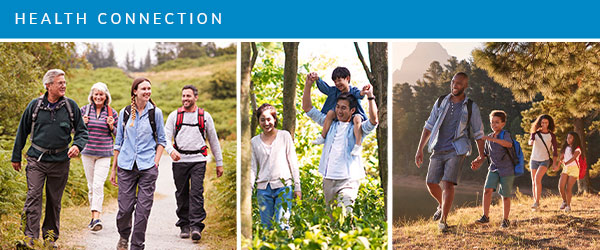Health Connection - December 2021

Taking the Guilt Out of Holiday Feasting
They’re back. The festive, food-filled, holidays are upon us. If, like most of us, you’re concerned about putting on a few pounds, here’s the good news. Studies show that the average person only gains about a pound and a half during the holidays. The bad news? Many of us won’t lose that weight in January, setting us up for more weight gain over time.
Here are a few tips to help you navigate the holidays without packing on the pounds:
- Choose your indulgences. If you’re a dessert lover, avoid the creamy crab dip or buttered rolls to save room for the pie. If you prefer savory over sweets, have another spoonful of stuffing and pass on dessert.
- Don’t panic if you’re on a weight loss journey. Focus on maintaining your current weight until January. The key is not to regain any of the weight you’ve lost so far.
- Watch out for situational eating. If you’re back working in an office, avoid the coffee or reception areas, where you might find cookies, candy, and caramel corn. When you’re shopping and running holiday errands, make sure you have a healthy dinner planned so you don’t end up eating fast food. If your fridge is packed with tasty leftovers, save them for mealtime. Freeze baked goods to enjoy another day or give your guests some pie to take home.
- Beware of the all or nothing mindset, as in ‘tis the season and I’m going to overindulge until 2022’. Instead, try to maintain your normal habits throughout the holiday month with occasional treats. As long as you go back to your healthy diet in between celebrations you’ll be set up to make better choices.
- Plan ahead. If you have an evening event to attend, don’t skip meals so you’re not starving by the time you get to the party.
- At holiday parties, limit alcoholic beverages to one or two. Alcohol has extra calories and lowers your inhibitions, which can lead you to make unhealthy choices. A glass of wine, light beer, or something “on the rocks” are all better choices than sweet mixed drinks.
- Watch out for snacks you can eat by the handful. Foods like caramel corn, chips, or party mix make it hard to know just how much you are eating. Nuts are healthy but the calories add up quickly and dried fruit has a high sugar content.
Smart Substitutions and Calorie Cutters
- Side Dishes. Use spaghetti squash or zucchini noodles instead of pasta to cut down on carbs. If you are bringing a dish to a potluck, consider roasted veggies with garlic and herbs. Mix roasted garlic in with your mashed potatoes instead of butter. Try mashed instead of candied sweet potatoes.
- Choose Healthy Fats. Try using olive or avocado oils when you cook.
- Desserts. Consult “Chef Google” for simple healthy ingredient swaps. Look for recipes using stevia or monk fruit sweeteners if you are trying to limit sugar. Vegan recipes use flax eggs, a surprisingly good substitute for the real thing. Apple sauce is a popular ingredient for quick breads. Use dates in puddings and smoothies.
- Stuffing. Remember not to bake your stuffing inside the bird – it will cook more slowly and may not reach 165°, the temperature needed to kill bacteria. Cut down on the bread by making the stuffing more veggie-heavy. If you can’t eat gluten, try making stuffing with gluten-free bread. You can also find some interesting quinoa-based stuffing recipes online.
- Family Recipes. We all love our family traditions. Still, you can make some small changes, like reducing the amount of sugar, honey, or maple syrup. Most recipes call for way more sweetener than needed. Chances are, Great Aunt Irma won’t know the difference.
There are many places you can find healthier choices for traditional holiday foods, from magazines such as Cooking Light or Eating Well, to vegetarian cookbooks such as Love and Lemons, to the Internet. But also remember, it’s OK to treat yourself even if your favorite holiday treat isn’t something you usually eat. Just remember to practice moderation and enjoy the holidays!
Keeping Your Holiday Stress Levels Under Control

The holiday season is a time to count your blessings, enjoy family and friends, and create wonderful memories. If only the preparations weren’t so exhausting! All that planning, traveling, shopping, decorating, socializing, meal preparation, and yes, tending to your usual responsibilities at home and at work! If we try to do it all, with a smile—and, yes, a mask—because there’s still COVID-19 to worry about, the potential to become overwhelmed is high.
No matter how efficient you are, all that activity can leave you feeling exhausted and drained. What are the signs that you need to slow down? You may have a hard time falling and staying asleep. Maybe you have trouble concentrating or remembering things. Or you’re irritable and impatient with others. Perhaps you’re one of those folks who take stress out on their body and you’re experiencing heartburn, or back and neck pain.
Parents and caregivers, while wanting to create special memories for their children, can fall prey to becoming the curator of everyone’s good time. If you notice you are influenced by comparing yourself to others on social media, try taking a break. You can always post your photos after the holidays… if that brings you joy.
For some, the holidays can bring up challenging emotions. Perhaps you have unpleasant memories of difficult family get-togethers. Or perhaps you are experiencing isolation, have lost a loved one or ended a marriage or relationship, making the holidays a sad time. Financial concerns and issues with substance abuse can be heightened during the holidays. If you fi nd yourself sliding into possible depression, don’t hesitate to seek help.
Realizing the stress of the holidays is getting to you is literally the first step to coping. Take a breather. Talk to a friend or family member who’s a good listener. Sneak in some exercise. Turn your attention inward with a mindfulness practice like yoga or meditation. Watch how much you eat and drink—don’t use the season as your reason to overindulge!
If your to-do list is daunting, sit down and draw a four-quadrant chart. Label each quadrant as follows: upper left is “important and urgent.” Upper right is “important, not urgent.” Bottom left is “urgent, not important.” And bottom right is “not important or urgent.” Now, sort the items in your to-do list into the appropriate category. Delete everything in the “not important or urgent” box that doesn’t reflect your values. For example, is rushing out to buy your child an additional gift more meaningful than getting outside for hike together?
Traveling to visit family you don’t see that often is a different type of holiday stress. Mental health practitioners recommend “coping ahead,” meaning anticipating stressful scenarios in advance and making a plan for how you will handle them. It’s common, and very normal, to revert to old childhood roles when you spend more than a couple of days with the family. Set boundaries and, if you think you need more space, don’t hesitate to book a hotel room. And remember, you can rebalance when you get home!
Understanding Heart Attacks in Women

If someone is generous, thoughtful, and kind, we may say they’re “big-hearted.” That metaphor, however, has nothing to do with actual anatomy. Dimensionally, a female’s heart is smaller than a male’s and some of the walls separating her heart’s chambers are thinner. Her heart also beats faster and releases roughly 10% less blood with each heartbeat. What’s more, those are not the only cardiovascular differences:
1. Biologically, a female’s arteries are smaller than a male’s and harder to see on an angiogram (a procedure that uses x-ray imaging to view the heart’s blood vessels), especially if a blockage is affecting smaller arteries. That’s why women who continue to have symptoms after an angiogram should see a cardiologist who specializes in women with heart disease.
2. In men, stress causes the heart arteries to constrict, raising blood pressure, whereas in women, stress raises the pulse rate, causing the heart to pump more blood.
Although heart disease is the leading cause of death in both women and men, biological sex makes a difference in the rate and severity of heart attacks. Males are more vulnerable to heart attacks than females, with 420,000 hospitalizations a year compared to 350,000 for women. Men also have heart attacks at a younger age: 65 on average for a first heart attack, compared to 72 for women. This is because of the protective effect of estrogen, which lasts until after menopause and dissipates over time. However, heart attacks are often more serious in women. They tend to be hospitalized longer and are more likely to die in the hospital. In the year following a first heart attack, women have a 50% higher chance of experiencing a deadly heart attack, and their odds of having a second heart attack within 6 years are nearly double those of men.
Risks for Women
- Sex-linked risk factors. Both sexes share the same familiar risk factors: high blood pressure, diabetes or pre-diabetes, high cholesterol, smoking, excess weight, and a family history of heart disease. However, certain diseases that only affect women also raise their risk of heart disease, including:
- Endometriosis
- Polycystic ovary disease
- Pregnancy-related diabetes and high blood pressure
- Subtle, sometimes ambiguous symptoms. Men often describe their chest pain during a heart attack as a crushing weight on the chest. While some women also experience chest pain, others may have subtler symptoms that could be confused with more benign conditions such as heartburn, muscle pain, or the flu. Unlike plaque rupture, which is often seen in men presenting with a heart attack, plaque erosion is often seen in women, which describes why symptoms in women are often subtle. In fact, it’s not uncommon for women to be unaware that they have had a mild heart attack and have sustained heart damage. This puts them at serious risk for a second, possibly fatal heart attack. Here are some signs you should never ignore:
- Sudden intense fatigue, sometimes accompanied by a heavy feeling in your chest, particularly if the fatigue hits after a simple activity like walking your dog or finishing your regular exercise routine
- Shortness of breath, often without exertion—it may be accompanied by chest pain or sudden debilitating fatigue and get worse when you lie down
- A cold sweat
- Pain in the neck, arms, chest, back or jaw, especially if the pain starts in the chest and spreads to the back and/or wakes you up at night
If you think you may be having a heart attack, don’t worry about “bothering” your doctor or calling 911 unnecessarily. Medical professionals know how confusing heart attack symptoms can be in women. Never diagnose yourself or shrug off concerning symptoms. Because heart attack symptoms are so often attributed to other causes—and thus ignored—the charts below can help you understand what you may be experiencing.
Panic Attack vs. Heart Attack
| PANIC ATTACK | HEART ATTACK |
| Sharp, stabbing chest pain | Squeezing sensation or pressure in the chest |
| Sudden onset that may be related to a situation | Sudden onset, often during physical exertion |
| Improves over 20-30 minutes | Worsens over time |
| Pain limited to chest | Pain radiates to the arms, back, shoulders, or jaw |
| Racing heart rate | Heart rate may not change, or may actually slow down |
| Trembling and shakiness | Nausea and vomiting |
| Tingling in the hands | No tingling in the hands |
Heartburn vs. Heart Attack
| HEARTBURN | HEART ATTACK |
| Burning sensation in the upper abdomen and throat. NO pain in back, jaw, arms, or shoulders. | Squeezing and pressure in the chest, possibly accompanied by pain in the back, jaw, arms, or shoulders. |
| Begins after eating, or while you are lying down or bending over | No connection to when you eat or your body position |
| Is relieved by antacids | Is NOT relieved by antacids |
| Can leave a sour taste in your mouth | Heart rate may not change, or may actually slow down |
| May be accompanied by belching and slight regurgitation | No belching or regurgitation. |
| No unusual sweating | Cold sweat |
| Nausea and vomiting | Nausea and vomiting |
| No shortness of breath | Shortness of breath |
| No dizziness or lightheadedness | Dizziness, feeling of lightheadedness |
| No fatigue | Sudden, extreme fatigue |
Remember, if you think you or a loved one may be experiencing symptoms of a heart attack, don’t wait. Call 911 immediately!
Learn more about women’s heart health here. And find out how natural life stages such as pregnancy and menopause can increase cardiovascular risk by listening to this short podcast.
Dr. Ines Sherifi is a board-certified cardiologist and cardiovascular imaging specialist at MarinHealth Cardiovascular Medicine | A UCSF Health Clinic.
Acupuncture: Modern Medicine Embraces an Ancient Healing Modality
By Camille Loveman, DACM, LA-C

Acupuncture is an ancient Chinese healing art. The earliest reference to acupuncture treatment is in The Yellow Emperor’s Classic of Internal Medicine, dating from about 100 BCE! Traditional Chinese medicine teaches that life energy, known as chi or qi, flows through 12 channels in the body called meridians. While these meridians represent different organs and functions in the body, they do not follow the exact pathways of our nervous or circulatory systems. You experience symptoms when the flow of chi is interrupted. Acupuncturists insert needles into specific points along the meridians to release and rebalance the flow of chi. Many practitioners of Western medicine interpret the acupuncture points as places to stimulate nerves, muscles, and connective tissue to boost your body's natural response to pain.
Western medicine is increasingly embracing acupuncture, and is now officially recognized by the National Institute of Health as a helpful and integrative treatment option for certain conditions. Studies have found acupuncture useful for reducing back, neck, knee, and osteoarthritis pain. Acupuncture is recommended by the American Pain Society and the American College of Physicians as a non-pharmaceutical approach to treat chronic low-back pain and may also be helpful in the prevention and/or treatment of migraine and tension headaches. Some providers also recommend acupuncture for dental pain, labor pain, menstrual cramps, allergic rhinitis, and nausea.
At MarinHealth Integrative Wellness Center, the bulk of our acupuncture patients are referred for osteoarthritic issues or chemo-related nausea. All our treatments are available to both MarinHealth patients and the community at large.
What to Expect During Treatment
Treatment normally involves several sessions. The initial intake and evaluation session takes longer. At MarinHealth Integrative Wellness Center, our initial session is 90 minutes long, 45 of which is spent discussing your issues and taking your medical history. Our follow-up sessions are an hour long: a 15-minute progress report from our clients followed by a 45-minute treatment. A common treatment plan typically involves one or two sessions a week. The number of weeks will depend on the condition and its severity.
Treatment is received lying down on a padded table, with the acupuncturist inserting very thin needles into various acupuncture points. (Don’t be surprised if some of these points are situated far from the area that is troubling you!) A typical treatment uses between five and twenty needles. These are disposable and can only be used once, per FDA regulations. Insertion is not painful, but you may feel a mild ache when a needle reaches the correct depth. Your practitioner may gently twirl the needles or apply heat or mild electrical pulses to them. The needles generally stay in place for 20 to 30 minutes while you lie still. There is usually no discomfort when the needles are removed.
Response to treatment is highly individualized. You may feel relaxed or energized, or you may not experience anything noticeable.
Before You Try Acupuncture
- First, talk to your doctor. He or she may know about the success rate of acupuncture for your condition. You may also be able to get a recommendation for an acupuncturist.
- Don’t “self-treat” a health problem by seeing an acupuncturist BEFORE talking to your doctor.
- Check out the acupuncturist’s credentials. The California Board of Acupuncture requires a master’s degree in Acupuncture. Some acupuncturists go on to obtain a doctorate. Acupuncturists must be familiar with diagnostics, potential counter-indications, and how the treatment may interact with certain medications. Certification requires passing an eight-hour exam.
- Find out whether your insurance company covers acupuncture and ask the practitioner about the cost and the estimated number of treatments needed. (Medicare will cover 20 sessions for low back pain.)
- Make sure you are not at risk for complications. Risk factors include:
- Having a bleeding disorder
- Taking blood thinners
- Having a pacemaker if your procedure will involve the application of electrical pulses to the needles
Learn more about acupuncture at MarinHealth’s Integrative Wellness Center, or call 1-628-336-7689 for more information or to schedule an appointment.
Camille Loveman is an Acupuncturist at MarinHealth Integrative Wellness Center.

